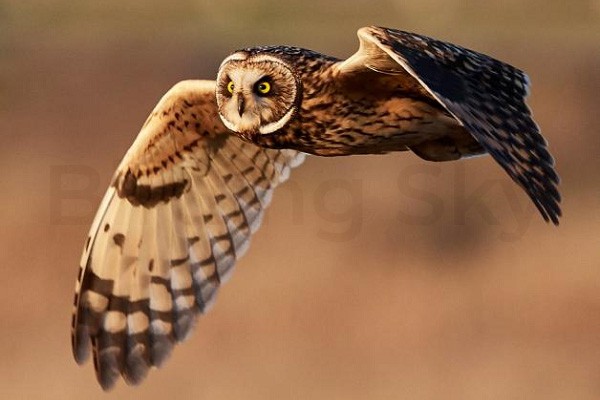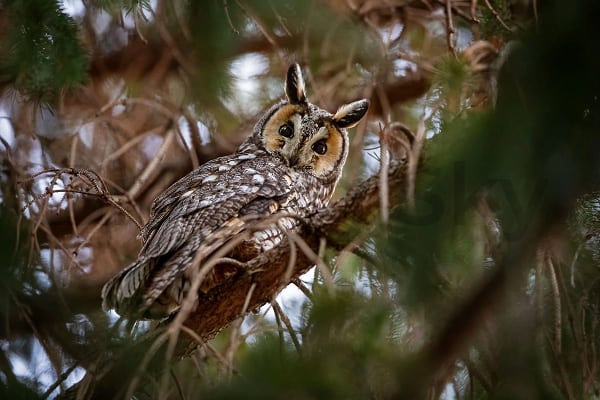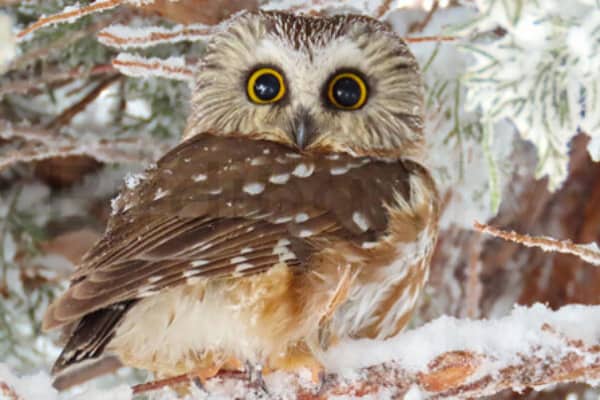Have you ever wondered about the different types of owls that can be found in Maryland? From the majestic Great Horned Owl to the elusive Snowy Owl, these creatures have captivated our imagination for centuries. But how much do you really know about the owls that call Maryland home? Join us on a journey through the fascinating world of Maryland’s owls, as we uncover their unique characteristics, habitats, and behaviors. Get ready to be amazed by stunning photos that bring these magnificent birds of prey to life.
Here are the main points:
- Explore the eight types of owls found in Maryland
- Learn about the physical features, habitats, and behaviors of each owl species
- Gain insights into the hunting techniques and communication methods of Maryland’s owls
- Discover the remarkable adaptability of owls during winter migration
- Uncover the rare and elusive Snowy Owl that occasionally graces Maryland with its presence
Types Of Owls In Maryland
When it comes to the diverse owl species found in Maryland, there is no shortage of fascinating creatures to discover. Whether you’re a nature enthusiast or simply intrigued by these majestic birds, this section will provide you with an in-depth look at the different types of owls that call Maryland home.
From the iconic Great Horned Owl, known for its impressive size and distinct ear tufts, to the elusive Snowy Owl, whose rare appearances create a sense of excitement among birdwatchers, each species has its own unique characteristics that make them truly captivating.
Let’s take a closer look at some of the remarkable owlspecies in Maryland:
- Great Horned Owl
- Barred Owl
- Barn Owl
- Eastern Screech Owl
- Short-Eared Owl (Winter Migrants)
- Long-Eared Owl (Winter Migrants)
- Northern Saw-Whet Owl (Winter Migrants)
- Snowy Owl (Rare)
Each owl species has its own physical features, habitat preferences, and behaviors that contribute to their fascinating nature. By exploring these unique traits, you’ll gain a deeper understanding of their adaptations, survival strategies, and the role they play in Maryland’s ecosystem.
Now, let’s dive into the enchanting world of Maryland owls and uncover the wonders of these magnificent birds.
Table: Types of Owls in Maryland
| Owl Species | Physical Features | Habitat | Behavior |
|---|---|---|---|
| Great Horned Owl | Distinctive ear tufts and powerful talons | Forests, open woodlands, and suburban areas | Nocturnal hunters with a broad diet |
| Barred Owl | Barred pattern plumage and hooting calls | Mixed forests near water sources | Skilled hunters with excellent hearing |
| Barn Owl | Heart-shaped face and silent flight | Barns, open fields, and grasslands | Nocturnal hunters with exceptional hearing |
| Eastern Screech Owl | Varied color morphs and small stature | Forests, woodlands, and parks | Nocturnal hunters with distinct vocalizations |
| Short-Eared Owl (Winter Migrants) | Long wings and small ear tufts | Marshes, grasslands, and agricultural fields | Aerial hunters known for their distinctive flight patterns |
| Long-Eared Owl (Winter Migrants) | Long ear tufts and cryptic plumage | Woodlands, thickets, and conifer forests | Nocturnal hunters with a preference for small mammals |
| Northern Saw-Whet Owl (Winter Migrants) | Small size and yellow eyes | Forests, woodlands, and thickets | Nocturnal hunters specializing in small prey |
| Snowy Owl (Rare) | White plumage with dark markings | Tundra and open grasslands during winter migration | Diurnal hunters capable of covering vast distances |
1. Great Horned Owl
The Great Horned Owls is one of the most common owl species found in Maryland. Known for its majestic appearance and powerful presence, the Great Horned Owl is a symbol of wisdom and grace in the avian world. Let’s explore the physical features, habitat, and behavior of this magnificent owl.

Physical Features
The Great Horned Owl stands out with its distinct ear tufts, which resemble horns and give it its name. These tufts are not actual horns but are made of feathers. They serve as a form of camouflage, helping the owl blend in with its environment and appear less conspicuous. With a wingspan of about 3-5 feet, the Great Horned Owl is an impressive sight when in flight. Its powerful talons are designed for gripping and capturing prey with precision.
Habitat
The Great Horned Owl is a versatile species that can adapt to various habitats, ranging from forests and woodlands to urban areas. They are found throughout Maryland, making it an ideal location for observing these awe-inspiring creatures up close. These owls are known for nesting in large trees, such as pine, oak, and cottonwood.
Behavior
The behavior of the Great Horned Owl is highly fascinating. They are primarily nocturnal, meaning they are most active during the night. Their exceptional night vision and acute hearing allow them to locate prey with ease. Small mammals, birds, and reptiles make up their diet. When hunting, they employ a stealthy approach, gliding through the air silently to ambush their unsuspecting prey.
| Physical Features | Habitat | Behavior |
|---|---|---|
| Distinctive ear tufts | Adaptable to various habitats | Nocturnal and stealthy hunter |
| Powerful talons | Often found in forests and woodlands | Feeds on small mammals, birds, and reptiles |
| Large wingspan | Nests in large trees | Excellent night vision and hearing |
Must Read Types of Owls in Wisconsin
2. Barred Owl
The Barred Owl is another fascinating owl species found in Maryland. With its distinctive physical features and unique behaviors, the Barred Owl is truly captivating.

Physical Features
The Barred Owl is known for its beautiful plumage featuring a barred pattern of brown and white feathers, hence its name. They have dark brown eyes and a rounded head with no ear tufts. Their wingspan can reach up to 44 inches (112 cm), and they can grow to be around 17-20 inches (43-51 cm) in length.
Habitat
Barred Owls prefer living in mature forests near water sources, such as swamps, wetlands, and rivers. They can also be found in wooded suburban areas, as long as there are suitable hunting grounds. These owls are adaptable and can thrive in various habitats as long as there is enough prey available.
Behavior
One of the most noteworthy behaviors of the Barred Owl is their distinctive hooting calls, often described as saying, “Who cooks for you? Who cooks for you all?” These vocalizations are commonly heard during their courtship and territorial defense.
The Barred Owl is an opportunistic predator and feeds on a wide variety of prey, including small mammals like voles, rabbits, and squirrels, as well as birds, reptiles, and amphibians.
They are primarily nocturnal predators, but they can also be active during dawn and dusk. Barred Owls are known for their silent flight, which allows them to surprise their prey without being detected.
Barred Owl Quick Facts
- Scientific name: Strix varia
- Family: Strigidae
- Conservation status: Least Concern
- Wingspan: Up to 44 inches (112 cm)
- Length: 17-20 inches (43-51 cm)
- Mainly found in: Mature forests near water sources
- Main prey: Small mammals, birds, reptiles, and amphibians
| Physical Features | Habitat | Behavior |
|---|---|---|
| – Distinctive barred pattern plumage – Dark brown eyes – Rounded head with no ear tufts – Wingspan up to 44 inches (112 cm) – Length of 17-20 inches (43-51 cm) | – Mature forests near water sources – Swamps, wetlands, rivers – Wooded suburban areas with suitable hunting grounds | – Vocalizations include distinctive hooting calls – Opportunistic predator feeding on a wide variety of prey – Primarily nocturnal and known for silent flight |
3. Barn Owl

The Barn Owl is a captivating owls that can be found in Maryland. With its heart-shaped face and silent flight, it is an enchanting bird to observe. Let’s delve into the physical features, preferred habitats, and hunting techniques of the Barn Owl.
Physical Features
The Barn Owl is known for its unique physical attributes that set it apart from other owl species. It has a heart-shaped face, which acts as a tool for capturing and focusing sound, aiding in their exceptional hearing abilities. With a wingspan of up to 42 inches and a body length of approximately 13-15 inches, these owls are considered medium-sized birds.
“The Barn Owl’s heart-shaped face acts as a tool for capturing and focusing sound, aiding in their exceptional hearing abilities.”
Preferred Habitats
The Barn Owl is adaptable and can be found in various habitats, but it is commonly associated with barns, abandoned buildings, and open fields. These birds are often attracted to areas with ample prey availability, such as rodents and small mammals.
Hunting Techniques
The Barn Owl is a skilled predator, relying primarily on its exceptional hearing to locate prey. As these owls fly silently, they can sneak up on their prey without being detected. Once located, they swoop down with incredible precision, capturing their prey with their sharp talons.
“The Barn Owl’s silent flight allows it to swoop down on prey with incredible precision, capturing them with its sharp talons.”
| Physical Features | Preferred Habitats | Hunting Techniques |
|---|---|---|
| The Barn Owl has a heart-shaped face and silent flight. | These owls can be found in barns, abandoned buildings, and open fields. | Barn Owls rely on their exceptional hearing to locate prey and capture them with their sharp talons. |
4. Eastern Screech Owl
The Eastern Screech Owl is a captivating owl species that can be found in Maryland. Although small in size, this owl is known for its big personality and distinct physical features.

One of the fascinating aspects of Eastern Screech Owls is their ability to change color morphs. These owls can come in two different color variations, gray and red, allowing them to blend seamlessly into their surroundings and remain hidden from potential predators.
When it comes to habitat, Eastern Screech Owls are adaptable and can be found in a variety of environments. They are commonly found in forests, woodlands, and suburban areas, where they take advantage of tree cavities or nest boxes for shelter.
As nocturnal hunters, Eastern Screech Owls are most active during the night, using their excellent hearing to locate prey. Their diet consists of small mammals, like mice and voles, as well as insects and birds.
These owls are known for their distinctive vocalizations, which include trills, whinnies, and descending whistles. Their calls are often used for territorial purposes and during courtship rituals.
Fun Fact:
The Eastern Screech Owl is a permanent resident of Maryland, meaning that it stays in the state throughout the year, unlike some other owl species that migrate.
“The Eastern Screech Owl’s ability to change color morphs and its unique vocalizations make it a fascinating owl species to observe in Maryland’s diverse habitats.” – Owl enthusiast
To learn more about the Eastern Screech Owl and other owl species in Maryland, refer to the table below for a quick overview of their physical features, habitats, and behaviors:
| Owl Species | Physical Features | Habitat | Behavior |
|---|---|---|---|
| Eastern Screech Owl | Small size, varying colors (gray or red) | Forests, woodlands, suburban areas | Nocturnal, excellent hearing, vocalizations |
| Great Horned Owl | Large size, distinctive ear tufts, powerful talons | Various habitats including forests, deserts, and urban areas | Nocturnal, territorial, opportunistic hunter |
| Barred Owl | Medium size, barred pattern plumage | Forests, swamps, wetlands | Nocturnal, territorial, hooting calls |
| Barn Owl | Medium size, heart-shaped face, silent flight | Open fields, barns, caves | Nocturnal, excellent hunter, specialized plumage for silent flight |
Other Owl Species in Different Regions
Owls in Georgia That You Can See
5. Short-Eared Owl (Winter Migrants)
During the winter months, Maryland becomes a temporary home for the Short-Eared Owl. This remarkable owl species migrates to the area, adding to the diversity of Maryland’s owl population. Let’s take a closer look at their physical features, preferred habitat, and hunting behavior.

Physical Features:
The Short-Eared Owl showcases distinct physical characteristics that set it apart from other owl species. With a wingspan of around 38-42 inches and a length of 13-17 inches, they have a medium-sized body. Their short, feathered ear tufts are barely visible, adding to their subtle appearance. Notably, these owls have yellow eyes, enhancing their captivating gaze.
Habitat:
Short-Eared Owls prefer open habitats such as marshes, grasslands, and farmlands. During their winter stay in Maryland, they can be found in coastal areas, fields, and meadows. These owls often choose areas with low vegetation, as it provides them with the cover necessary for hunting and roosting.
Behavior:
The Short-Eared Owl is primarily active during dusk and dawn, making them crepuscular hunters. They have a unique hunting style, utilizing both their keen eyesight and acute hearing to locate their prey. These owls primarily feed on small mammals, including mice, voles, and shrews. In pursuit of their prey, they perform quartering flight patterns, hovering and scanning the ground below for any signs of movement. Once their target is detected, they swoop down swiftly and silently to capture their meal.
Comparison of Short-Eared Owl with Other Maryland Owl Species
Let’s compare the Short-Eared Owl with some of the other owl species found in Maryland:
| Owl Species | Physical Features | Habitat | Behavior |
|---|---|---|---|
| Short-Eared Owl | – Medium-sized body – Short feathered ear tufts – Yellow eyes | – Marshes – Grasslands – Farmlands | – Crepuscular – Hunting using keen eyesight and acute hearing |
| Great Horned Owl | – Large body – Prominent ear tufts – Yellow eyes | – Forests – Woodlands – Urban areas | – Nocturnal – Hunting using powerful talons |
| Barred Owl | – Medium to large body – No ear tufts – Dark eyes | – Forests – Wetlands | – Nocturnal – Vocalizations including hooting calls |
| Barn Owl | – Medium-sized body – Heart-shaped face – Dark eyes | – Barns – Open fields | – Nocturnal – Silent flight and precise hunting techniques |
| Eastern Screech Owl | – Small to medium-sized body – Various color morphs – Yellow eyes | – Woodlands – Suburban areas | – Nocturnal – Camouflaged plumage and distinct vocalizations |
6. Long-eared owl
In the chilly winter months, Maryland becomes home to some fascinating owl species, including the Long-Eared Owl, the Northern Saw-Whet Owl, and the elusive Snowy Owl. These winter migrants bring a touch of enchantment to the state and captivate bird enthusiasts with their unique physical features, habitats, and behaviors.

The Long-Eared Owl, as its name suggests, is easily recognizable by its long ear tufts, which are not actually ears but merely feathers used for communication and camouflage. Their preferred habitat includes dense forests, where they can blend into the surroundings and hunt for small rodents under the cover of darkness. Observing their silent flight and listening to their low hooting calls is truly a mesmerizing experience.
7. Northern Saw-Whet Owl (Winter Migrants)

The Northern Saw-Whet Owls, another winter visitor to Maryland, may be small in size, but it compensates with its mighty hunting skills. With its rounded head and piercing yellow eyes, this owl species captures the hearts of many birdwatchers. Often found in coniferous forests, they mostly feed on mice and small birds, relying on their superb hearing and precise flight to make successful hunting attempts.
8. Snowy Owl (Rare)

Lastly, the rare Snowy Owl occasionally graces Maryland with its presence during the winter months. These majestic birds, with their white plumage and piercing yellow eyes, stand out against any backdrop. Native to the Arctic, they migrate south in search of food. Exploring open fields and coastal areas, Snowy Owls are known for their incredible hunting prowess and their ability to endure the harshest weather conditions.
As winter migrants, the Long-Eared Owl, Northern Saw-Whet Owl, and Snowy Owl bring a sense of wonder and excitement to Maryland’s diverse wildlife. Their physical features, choice of habitat, and hunting strategies make each species a true marvel of nature. So, keep your eyes peeled and your binoculars ready for a chance to catch a glimpse of these remarkable owl species during your winter adventures in Maryland.
FAQs About Owls in Maryland
Q1: What is the most common owl in Maryland?
The Eastern Screech Owl, Barred Owl, and Great Horned Owl are among the most common owl species in Maryland.
Q2: Does Baltimore have owls?
Yes, owls can be found in and around Baltimore, particularly in parks, wooded areas, and green spaces.
Q3: Is it legal to own an owl in Maryland?
Owning an owl as a pet is generally illegal in Maryland. Owls are protected under state and federal laws.
Q4: What kind of owls live in DC?
Owls found in Washington, D.C., include the Eastern Screech Owl, Barred Owl, and Great Horned Owl. Various species may inhabit parks and natural areas.
Q5: Where do owls live in Maryland?
Owls in Maryland inhabit diverse environments, including forests, parks, and rural areas. Common locations include places like Cunningham Falls State Park, Blackwater National Wildlife Refuge, and the C&O Canal National Historical Park.
